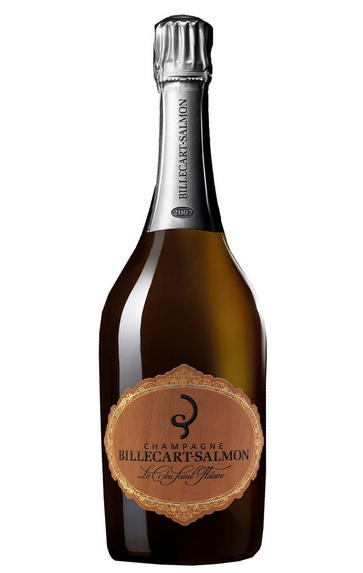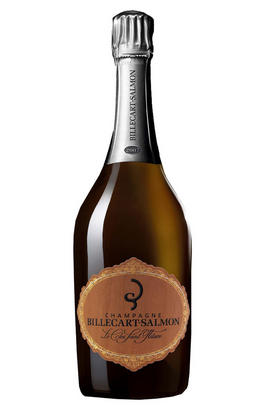
2006 Champagne Billecart-Salmon, Cuvée Le Clos Saint-Hilaire, Brut

Critics reviews
The 2006 Le Clos Saint-Hilaire is fabulous. In this radiant year, the Clos Saint-Hilaire has a touch more mid-palate sweetness and generosity, but that’s a good thing, as it balances some of the more austere leanings that can make young vintages hard to appreciate upon release. Apricot, lemon confit, ginger, graphite, spice and crushed rocks are strands in a gorgeous, captivating tapestry that dazzles right out of the gate. The precision here is just mind-blowing. Billecart's 2006 Clos Saint-Hilaire is a very special Champagne, that much is very clear.
Drink 2024 - 2036
Antonio Galloni, Vinous.com (July 2022)
Harvested late September. In barrel until April 2007. Disgorged November 2020. Dosage 2 g/l. To be released in 2022.
Rich nose, yeasty and so alive. The oak shows even more as the wine opens up, giving a cedar spice. Such underlying depth and richness with such a surprising mineral and acidic backbone with a verbena note, mandarin – the most citric of the lot. There is a subtler nuttiness here that is almost creamy, like a Belgian chocolate, almost oily on the finish yet with such direction. (AC)
Drink 2025 - 2045
Jancis Robinson MW, JancisRobinson.com (October 2021)
Disgorged in November 2020 with two grams per litre dosage, Billecart-Salmon's newly released 2006 Brut Le Clos Saint-Hilaire is showing well, unwinding in the glass with aromas of pear, mirabelle plum, dried fruits, walnuts, bee pollen and spices. Full-bodied, layered and vinous, it's a concentrated, muscular young wine, allying maturing flavours with broad structural shoulders and racy acids and concluding with a long, resonant and slightly mordant finish. From a parcel planted in 1964 and vinified entirely in oak, this is a powerful Champagne of considerable presence that needs some more time on the cork to unwind and round out.
Drink 2023 - 2036
William Kelley, Wine Advocate (August 2022)
2g/l dosage. Disgorged November 2020. 6,750 bottles.
Baked raspberries, salted yellow plums, figs, walnuts, orange zest, mahogany and some toasted vanilla on the nose. Medium to full-bodied with beautifully integrated, very fine bubbles. Dry, with exciting and unique white-pepper and sea-salt notes. Seamless. So harmonious. Salty and spicy clove notes evolve at the end. Amazing precision. Single parcel Pinot Noir, 100% vinified in oak barrels. No malo.
Drink or hold
James Suckling, JamesSuckling.com (December 2022)
Although it was disgorged in November 2020, Mathieu Roland Billecart has been keen to delay the release. The ageing post disgorgement is just as important as that before it and sometimes overlooked, he maintains. The wine has an attractive Welsh gold colour, a lively and persistent mousse, and seductive aromas of nectarine, greengage and Victoria plum. I even noted a hint of spearmint. The palate maintains a youthful nervosité; behind that generous fruit, including red fruit (cherry mainly), hints of brioche and hazelnut and then an authoritative finish. Great potential.
Drink 2022 - 2036
Simon Field MW, Decanter.com (October 2021)
About this WINE

Champagne Billecart-Salmon
Champagne Billecart-Salmon was founded in 1818 in the village of Mareuil-sur-Aÿ near Epernay. It remains family-owned and run; Mathieu Roland-Billecart represents the seventh generation here, following in the footsteps of founders Nicolas-François Billecart and Elisabeth Salmon.
A family tasting committee meets weekly, joined by chef du cave Florent Nys. The eight-person panel includes three generations of the family, notably including Jean Roland-Billecart (who alone has over 75 vintages of experience). Not one cuvée is released until every member of the committee agrees on the blend.
Billecart-Salmon is a large Champagne House, with around 100 hectares of vines of its own. The process of organic conversion for the vineyards was started in 2019. The house also buys fruit from growers covering another 300 hectares of vines. Most of the fruit comes from the Champagne sub-regions of Montagne de Reims, Vallée de la Marne and Côte des Blancs.

Brut Champagne
Brut denotes a dry style of Champagne (less than 15 grams per litre). Most Champagne is non-vintage, produced from a blend from different years. The non-vintage blend is always based predominately on wines made from the current harvest, enriched with aged wines (their proportion and age varies by brand) from earlier harvests, which impart an additional level of complexity to the end wine. Champagnes from a single vintage are labelled with the year reference and with the description Millésimé.
Non-vintage Champagnes can improve with short-term ageing (typically two to three years), while vintages can develop over much longer periods (five to 30 years). The most exquisite and often top-priced expression of a house’s style is referred to as Prestige Cuvée. Famous examples include Louis Roederer's Cristal, Moët & Chandon's Dom Pérignon, and Pol Roger's Cuvée Sir Winston Churchill.
Recommended Producers : Krug, Billecart Salmon, Pol Roger, Bollinger, Salon, Gosset, Pierre Péters, Ruinart

Champagne blend
Which grapes are included in the blend, and their proportion, is one of the key factors determining the style of most Champagnes. Three grapes are used - Pinot Noir, Chardonnay and Pinot Meunier.
26% of vineyards in Champagne are planted with Chardonnay and it performs best on the Côtes des Blancs and on the chalk slopes south of Epernay. It is relatively simple to grow, although it buds early and thus is susceptible to spring frosts. It produces lighter, fresher wines than those from Burgundy and gives finesse, fruit and elegance to the final blend. It is the sole grape in Blancs de Blancs, which are some of the richest long-lived Champagnes produced.
Pinot Noir accounts for nearly 40% of the plantings in Champagne and lies at the heart of most blends - it gives Champagne its body, structure, strength and grip. It is planted across Champagne and particularly so in the southern Aube district.
The final component is Pinot Meunier and this constitutes nearly 35% of the plantings. Its durability and resistance to spring frosts make the Marne Valley, a notorious frost pocket, its natural home. It ripens well in poor years and produces a soft, fruity style of wine that is ideal for blending with the more assertive flavours of Pinot Noir. Producers allege that Pinot Meunier lacks ageing potential, but this does not deter Krug from including around 15% of it in their final blends.


Buying options
Add to wishlist
Description
The 2006 Le Clos Saint-Hilaire is fabulous. In this radiant year, the Clos Saint-Hilaire has a touch more mid-palate sweetness and generosity, but that’s a good thing, as it balances some of the more austere leanings that can make young vintages hard to appreciate upon release. Apricot, lemon confit, ginger, graphite, spice and crushed rocks are strands in a gorgeous, captivating tapestry that dazzles right out of the gate. The precision here is just mind-blowing. Billecart's 2006 Clos Saint-Hilaire is a very special Champagne, that much is very clear.
Drink 2024 - 2036
Antonio Galloni, Vinous.com (July 2022)
wine at a glance
Delivery and quality guarantee